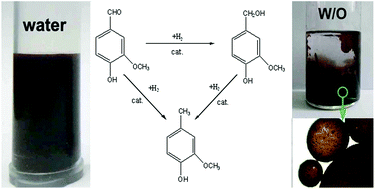Hydrodeoxygenation of vanillin as a bio-oil model over carbonaceous microspheres-supported Pd catalysts in the aqueous phase and Pickering emulsions†
Abstract
A series of amphiphilic carbonaceous microspheres-supported Pd catalysts have been prepared and their performances for the hydrodeoxygenation of vanillin have been investigated in both a pure aqueous phase and in water–oil biphasic systems. The wettability of the catalyst could be facilely tuned by adjusting the hydrothermal treatment temperature during the synthesis of the carbonaceous microspheres or by a post-treatment process in alkaline solution. In the aqueous phase reactions, the more hydrophilic the catalyst, the more active it was for the hydrodeoxygenation of vanillin. And the wettability of the support affects the activity through the interaction between the catalysts and substrates/products. In the case of a water–oil biphase, the wettability of the support played a key role in forming Pickering emulsions. It was found that the selectivity of the hydrodeoxygenation reactions was determined by the type of Pickering emulsion and high selectivity of p-creosol could be achieved in the water-in-oil emulsion systems.


 Please wait while we load your content...
Please wait while we load your content...